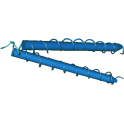
- Remove this product from my favorite's list.
- Add this product to my list of favorites.
Products
Viewed products
Newsletter
 |  |  |  |  |  |

Background: PKG kinases are members of the AGC kinase family. The different isoforms, PKG type I and II, acts as key mediator of nitric oxide (NO) and the second-messenger cyclic 3′,5′-guanosine-monophosphate (cGMP). At their N termini, coiled coils promote a parallel homodimeric configuration, followed by an autoinhibitory domain (AI) and two tandem cyclic nucleotide (cNT) binding sites, which cooperatively regulate C-terminal catalytic activity. The N-terminus of PKG-I is encoded by two alternatively spliced exons that specify for the PKG-Iα and PKG-Iβ isoforms. Upon binding of cGMP to the regulatory domain at two sites an activation of the protein kinase is promoted and PKG is able to phosphorylate serines and threonines on many cellular proteins involved in the regulation of platelet activation and adhesion, smooth muscle contraction, cardiac function, gene expression and feedback of the NO-signaling pathway.
Protein kinase G (PKG), cGMP-dependent, type I alpha isoform, bovine.
Expression system: Baculovirus infected Sf9 cells
Storage buffer: 50 mM phosphate, pH 6.8, 2 mM benzamidine, 1mM EDTA, 50% glycerol and 100 mM ß-mercaptoethanol
Protein concentration: 0.72 mg/ml (Bradford method using BSA as standard protein)
Specific activity: 1 U/mg (One unit is defined as the amount Protein Kinase G, required to incorporate 1 pmol of phosphate into the substrate peptide kemptide (LRRASLG) in one minute at 25°C using 450 nM cGMP.)
Basal activity: 0.7 U/mg (One unit is defined as the amount Protein Kinase G, required to incorporate 1 pmol of phosphate into the substrate peptide kemptide (LRRASLG) in one minute at 25°C using 0 nM cGMP.)
Entrez Gene ID: 282004
UniProtKB: P00516
Ordering information: shipped on dry ice
Brent W. Osborne, Jian Wu, Caitlin J. McFarland, Christian K. Nickl, Banumathi Sankaran, Darren E. Casteel, Virgil L. Woods, Jr., Alexandr P. Kornev, Susan S. Taylor, Wolfgang R. Dostmann (2011) “Crystal Structure of cGMP-dependent Protein Kinase Reveals Novel Site of Interchain Communication” Structure. 19(9): 1317–1327
Fiscus (2002)”Involvement of cyclic GMP and protein kinase G in the regulation of apoptosis and survival in neural cells.” Neurosignals. 11(4):175-90.
Moon TM1, Osborne BW, Dostmann WR. (2013) “The switch helix: a putative combinatorial relay for interprotomer communication in cGMP-dependent protein kinase.” Biochim Biophys Acta.1834(7):1346-51.
Wall ME, Francis SH, Corbin JD, Grimes K, Richie-Jannetta R, Kotera J, Macdonald BA, Gibson RR, Trewhella J. (2003) “Mechanisms associated with cGMP binding and activation of cGMP-dependent protein kinase.” Proc Natl Acad Sci U S A. 2003 Mar 4;100(5):2380-5.
Kötter S1, Gout L, Von Frieling-Salewsky M, Müller AE, Helling S, Marcus K, Dos Remedios C, Linke WA, Krüger M. (2013) "Differential changes in titin domain phosphorylation increase myofilament stiffness in failing human hearts."Cardiovasc Res. 99(4):648-56.
Follow us